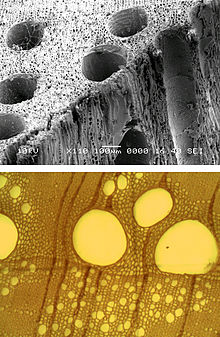Vessel element
In botany, the term trachea refers to a vascular element of the xylem located in the vascular bundle of the shoot axis of higher plants. Covered seed plants transport water from the roots to the leaves in the tracheae. The main driving force for this is transpiration suction, which is explained by the cohesion theory. In addition, root pressure may play a role, e.g. in spring. Tracheae, like tracheids, consist of dead, lignified cells.
In tracheids, the cell walls are completely or partially dissolved in the axial direction. Within a vessel, several tracheal cells are interconnected, forming a long continuous tube compared to tracheids. The totality of tracheae (together with the tracheids) thus forms a continuous and communicating tube system from the roots to the leaves.
In the transverse direction, water transport is possible by means of mottles. The pinnules of angiosperms are simpler than the pinnules of the torus-margo type of gymnosperms. The tracheal membrane consists of a net-like tangle of microfibrils. The very small "meshes" of the spotted membrane prevent the spread of the gas phase in the event of an embolism, since the menisci that form at the water-gas interface can withstand very high pressures (Young-Laplace equation). However, if the pressure difference between the water and gas sides is too great, adjacent vessels may also embolize. Local limitation of embolism can therefore probably be better achieved with gymnosperm yardsticks, as these function like non-return valves.
One can distinguish between tracheae and tracheids by examining a cross-section of a histological specimen for the axial walls of the respective vessels. Tracheae also often have a much larger diameter. In contrast to tracheids, they are exclusively responsible for water conduction. At the same time, tracheids contribute to the mechanical stabilization of the plant (double function). In deciduous trees, additional wood fibre cells increase mechanical stability. Due to the larger diameter, the volume flow in tracheae is significantly higher than in tracheids (Hagen-Poiseuille's law), however, the risk of vascular embolism due to tearing of the water filament increases. Most gymnosperms have only tracheids for water transport (exception: Gnetales). In contrast, most angiosperms have both tracheae and tracheids (exceptions are for example the Winteraceae and Trochodendraceae, which have no tracheae).

SEM (top) and light microscope image (bottom) of vessel elements (oak)
Questions and Answers
Q: What is a vessel element?
A: A vessel element is a cell type found in xylem, which is the water conducting tissue of plants.
Q: Where are vessel elements found?
A: Vessel elements are found in flowering plants or angiosperms, but not in most gymnosperms such as conifers.
Q: What is the main feature that distinguishes the hardwood of angiosperms from the softwood of conifers?
A: The main feature that distinguishes the hardwood of angiosperms from the softwood of conifers is the presence of vessel elements.
Q: What is the function of a vessel element?
A: The function of a vessel element is to transport water and minerals from the roots to the leaves of a plant.
Q: Are vessel elements present in all types of plants?
A: No, vessel elements are only found in flowering plants or angiosperms, but not in most gymnosperms such as conifers.
Q: What is the other type of cell found in xylem, besides vessel elements?
A: The other type of cell found in xylem is the tracheid, which is found in both angiosperms and gymnosperms.
Q: How do vessel elements differ from tracheids?
A: Vessel elements are larger and more efficient at transporting water than tracheids. They also have perforations on their walls that allow for faster water flow.
Search within the encyclopedia